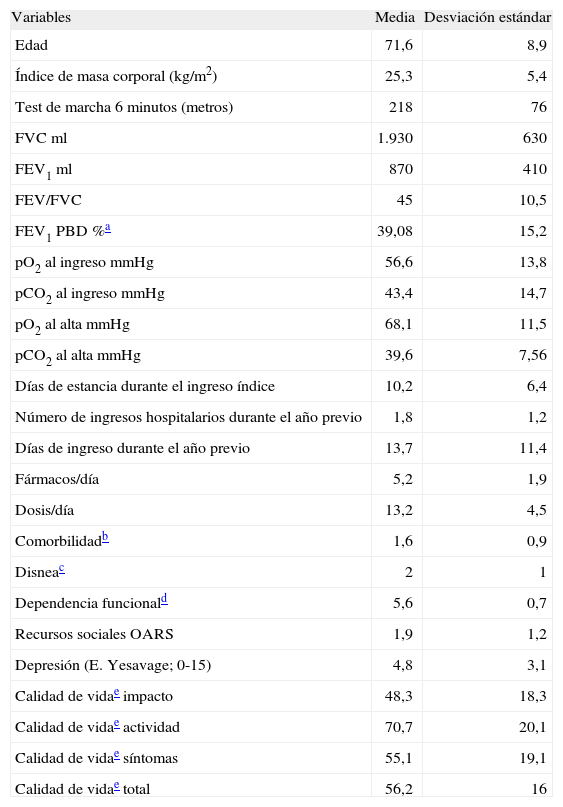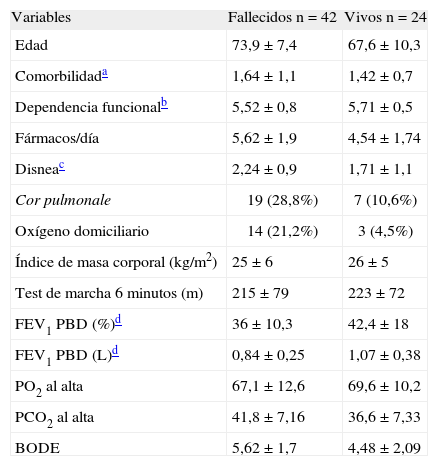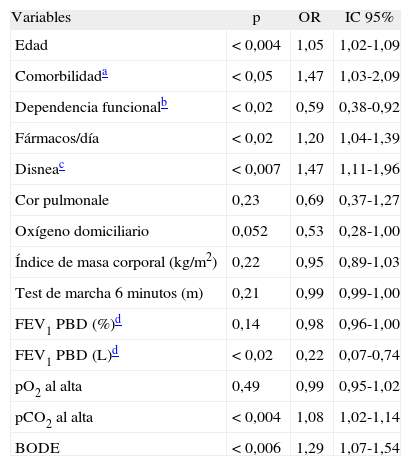El índice BODE es un buen predictor de mortalidad en pacientes ambulatorios con enfermedad pulmonar obstructiva crónica (EPOC), aunque no se ha demostrado su utilidad en los pacientes hospitalizados.
Material y métodosEstudiamos prospectivamente los pacientes hospitalizados por exacerbación de la EPOC con uno o más ingresos en el año previo. Al alta se valoró la dependencia funcional previa, la comorbilidad, la depresión y la calidad de vida, entre otras variables. Se realizó una prueba de marcha de 6 minutos, una espirometría con prueba broncodilatadora, se valoró la escala de disnea, el índice de masa corporal y se calculó el índice BODE.
ResultadosSe incluyeron 66 pacientes con una edad media de 71,6 ± 8,9 años. Fallecieron 42 pacientes (63,6%) antes del final del estudio (mediana de seguimiento de 1.490 días). La mortalidad fue más elevada en los pacientes más ancianos (p < 0,004), con más comorbilidad (p < 0,05) y con peores puntuaciones en la escala de disnea (p < 0,008) y en el índice BODE (p < 0,006; odds ratio [OR] 1,3; intervalo de confianza [IC] 95%: 1,07-1,54). La dependencia funcional (p < 0,02) y la pCO2 ≥ 45 mmHg al alta (p < 0,001) fueron también predictores de mortalidad. En el análisis multivariante sólo la hipercapnia y el índice BODE fueron variables predictoras independientes de mortalidad.
ConclusionesEl índice BODE calculado al alta hospitalaria es una variable útil como predictor de mortalidad posterior en pacientes reingresadores por EPOC. Su capacidad pronóstica es superior al FEV1.
The BODE index can accurately predict mortality in ambulatory patients with COPD, although its utility in hospitalized patients is unknown.
Material and methodsWe prospectively evaluated all patients hospitalized during one year for acute exacerbation of COPD with one or more admissions in the previous year. On discharge, previous functional dependence, comorbidity, depression and quality of life, among other variables, were evaluated. Body mass index, 6-minute walking test, dyspnea scale and spirometry with a post-bronchodilator test were performed on the last day of hospitalization and the BODE index was calculated using these data.
ResultsA total of 66 patients were included, with a mean age of 71.6 ± 8.9 years. Of these patients, 42 (63.6%) died before the end of the study (median follow-up 1,490 days). A higher mortality was observed among the oldest patients (p < 0.004), those with more comorbidities (p < 0.05), worse score on the BODE index (p < 0.006; OR 1.3; CI 95%: 1.07-1.54) and the dyspnea scale (p < 0.008). Functional dependence (p < 0.02), and pCO2 > 45 mmHg at discharge (p < 0.001) were also significant predictors of mortality. In the multivariate analysis, only hypercapnia (p < 0.004; OR 3.48; CI 95% 1.49-8.14) and the BODE index (p < 0.0005; OR 1.47; CI 95%: 1.18-1.82) were independent predictors of mortality.
ConclusionsThe BODE index measured at hospital discharge is an accurate and reliable predictor of mortality in patients who require several admissions for acute exacerbations of COPD.
Article
Diríjase desde aquí a la web de la >>>FESEMI<<< e inicie sesión mediante el formulario que se encuentra en la barra superior, pulsando sobre el candado.

Una vez autentificado, en la misma web de FESEMI, en el menú superior, elija la opción deseada.

>>>FESEMI<<<













